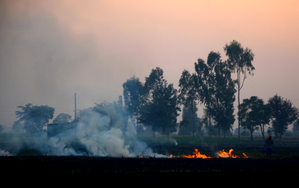Chandigarh: The agrarian state of Haryana is tackling the tricky issue of crop residue by offering farmers subsidies ranging from 50 to 80 percent on equipment for its management and importantly by offering financial incentives for paddy diversification with alternative crops.
The paddy season is mainly blamed for the farm fires that cause pollution in the Delhi-National Capital Region (NCR) in the winter season.
As per the plan, the state aims to manage 37 lakh tonnes of paddy straw, with almost one-third of this resource being repurposed by the industry.
While an estimated 13.54 lakh metric tonnes of straw is likely to be consumed by major industries, the government plans to manage five lakh acres of paddy straw with the aid of the Pusa Bio Decomposer.
The Haryana government says that from 2018-19 to 2021-22, a total of 41,331 crop residue management machines and equipment were made available to individual farmers with a subsidy of 50 percent. This was done to mitigate pollution in Delhi-NCR caused by the burning of biomass by farmers.
Additionally, 6,775 custom hiring centers were established with an 80 percent subsidy, and over Rs 584 crore has been provided as a subsidy to farmers.
In 2022-23 as many as 7,294 farmers purchased crop residue management agricultural machinery with a subsidy of Rs 82 crore. In this fiscal the government of India has allocated Rs 300 crore to the state for the implementation of the scheme.
Haryana currently has more than 80,000 crop residue management machines.
The government on Friday claimed that satellite images issued by NASA on stubble burning exposed the apparent discrepancies in claims made by the governments of Delhi and Punjab regarding the reduction in farm fires in the region.
A government spokesperson said that the satellite images indicate a staggering difference in the number of active biomass-burning cases, with Punjab having more than double the instances as compared to Haryana.
These differences certainly outline Haryana’s efforts in tackling the issue, said the spokesperson.
“NASA has exposed the tall claims made by the Delhi and Punjab governments that wrongly implicate Haryana in incidents of stubble burning related to pollution in New Delhi,” said the spokesperson.
Regarding stubble-burning incidents, Chief Minister Manohar Lal Khattar, who believes the success of climate-smart agriculture hinges on collaboration, told the media that Haryana has fewer cases of biomass burning compared to Punjab, which has seen more than 4,000 such incidents to date.
He said the government is providing financial incentives to farmers to discourage stubble burning and encourage the commercial utilization of crop residue.
The state offers financial incentives like Rs 1,000 per acre for in-situ or ex-situ management of paddy crop residue, Rs 7,000 per acre for diversification of paddy area with alternative crops under the ‘Mera Pani, Meri Virasat’ scheme and Rs 4,000 per acre for the adoption of direct sowing of rice, a viable water-saving alternative to traditional transplanting methods.
Also, panchayats in the ‘red zones’ that successfully achieve the zero-burning target are rewarded with Rs 1 lakh, while villages in the ‘yellow zones’ reaching the zero-burning goal will receive Rs 50,000 as an incentive.
Additionally, transportation charges for bales have been set at Rs 500 per acre, with a maximum limit of Rs 15,000 to support cow shelters.
Between September 15 to October 24 this year, Punjab registered 2,306 farm fire cases compared to 5,617 cases in the corresponding period last year.
Haryana, during this period, registered only 813 cases as compared to 1,360 cases registered in 2022.
In Haryana, the Confederation of Indian Industry (CII) has adopted 77 villages in partnership with corporates, including Apraava Energy, SBI Card, ONGC, and Birlasoft, where six custom hiring centers with 240 machines have been set up which are managed by farmers’ cooperatives formed by CII.
In 2022, incidents of stubble burning were reduced significantly in 26 villages in Sirsa district due to project interventions as hundreds of farmers joined the effort to create a zero-stubble burning movement.
While the focus of interventions till last year was on in-situ measures, in the current season village-level ex-situ interventions for the management of straw are also being promoted by CII in Sirsa.
Birlasoft, which is part of the $2.9 billion diversified CK Birla Group, has partnered with Punjab Agricultural University (PAU) and has been working in villages in Haryana and Punjab to reduce crop residue burning by raising awareness about stubble burning and providing farmers with sustainable straw management solutions.
Birlasoft’s initiative, ‘Shodhan’ (purification) has, with the help of local and corporate volunteers, covered 100 plus villages and 70,000 acres in Punjab and Haryana, benefiting 48,000 families, within four years.
A majority of the target farmers have not gone back to the old ways of biomass burning, it says.
In a survey conducted by the CII of 342 respondents in the program area, 96 percent of respondents reported better air quality.
A total of 27,000 tonnes of rice straw was prevented from being burnt while nearly 25,000 tonnes of biomass was recycled back into the soil.
Courtesy: “IANS”
A seasoned journalist with over two decades of experience, Vishal writes on a wide range of subjects which include biodiversity, climate change and links between environment & development. He also covers politics and other developments in Punjab and Himachal Pradesh. He lives in Chandigarh & Shimla.




